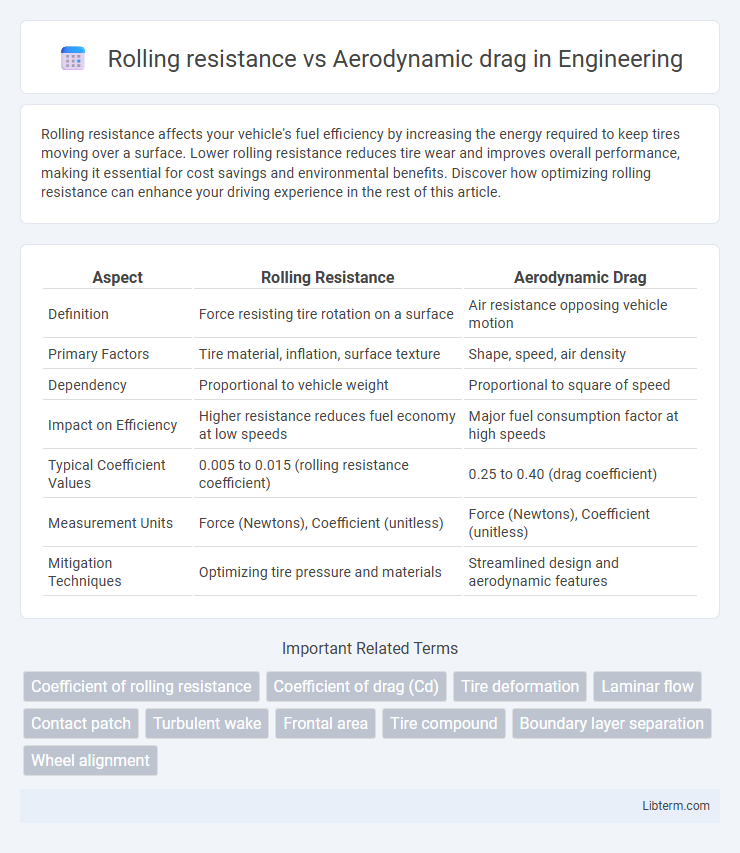Rolling resistance affects your vehicle's fuel efficiency by increasing the energy required to keep tires moving over a surface. Lower rolling resistance reduces tire wear and improves overall performance, making it essential for cost savings and environmental benefits. Discover how optimizing rolling resistance can enhance your driving experience in the rest of this article.
Table of Comparison
| Aspect | Rolling Resistance | Aerodynamic Drag |
|---|---|---|
| Definition | Force resisting tire rotation on a surface | Air resistance opposing vehicle motion |
| Primary Factors | Tire material, inflation, surface texture | Shape, speed, air density |
| Dependency | Proportional to vehicle weight | Proportional to square of speed |
| Impact on Efficiency | Higher resistance reduces fuel economy at low speeds | Major fuel consumption factor at high speeds |
| Typical Coefficient Values | 0.005 to 0.015 (rolling resistance coefficient) | 0.25 to 0.40 (drag coefficient) |
| Measurement Units | Force (Newtons), Coefficient (unitless) | Force (Newtons), Coefficient (unitless) |
| Mitigation Techniques | Optimizing tire pressure and materials | Streamlined design and aerodynamic features |
Understanding Rolling Resistance
Rolling resistance is the force resisting the motion when a tire rolls on a surface, primarily caused by tire deformation and energy loss within the tire material. It accounts for a significant portion of energy consumption at low speeds, especially under 30 mph, where tire-road interaction dominates over aerodynamic effects. Understanding rolling resistance involves analyzing tire composition, inflation pressure, and road surface texture to optimize fuel efficiency and performance in vehicles.
What Is Aerodynamic Drag?
Aerodynamic drag is the resistance force caused by air pushing against a moving object, significantly impacting vehicle speed and fuel efficiency. It increases exponentially with velocity due to air pressure differences and turbulence around the vehicle's surface. Compared to rolling resistance, aerodynamic drag becomes the dominant force at higher speeds, requiring streamlined designs to minimize energy loss.
Key Factors Influencing Rolling Resistance
Rolling resistance primarily depends on factors such as tire composition, tire pressure, and road surface texture, which affect the energy lost as the tire deforms while rolling. Heavier vehicle weights increase rolling resistance due to greater deformation and friction between tire and road. Unlike aerodynamic drag, which varies with speed and vehicle shape, rolling resistance remains relatively constant but plays a crucial role in fuel efficiency at lower speeds.
Primary Causes of Aerodynamic Drag
Aerodynamic drag primarily arises from factors such as air viscosity, shape of the vehicle, and flow separation, which create pressure differences and turbulent wake regions behind the vehicle. Surface roughness and frontal area significantly influence drag by increasing friction and resistance against airflow. Understanding these factors is essential for optimizing vehicle design to reduce drag and improve fuel efficiency, distinguishing it from rolling resistance caused by tire deformation and road interaction.
Rolling Resistance vs Aerodynamic Drag: What’s the Difference?
Rolling resistance and aerodynamic drag are two primary forces opposing a vehicle's motion, with rolling resistance resulting from the deformation of tires and contact with the road surface. Aerodynamic drag arises from air resistance as a vehicle moves, increasing exponentially with speed and influenced by the vehicle's shape and frontal area. Understanding the distinct impact of rolling resistance and aerodynamic drag on fuel efficiency and performance helps optimize tire selection and vehicle design for different driving conditions.
Impact on Fuel Efficiency and Energy Consumption
Rolling resistance and aerodynamic drag are critical factors affecting fuel efficiency and energy consumption in vehicles. Rolling resistance increases with tire deformation and road friction, causing higher fuel consumption at lower speeds, while aerodynamic drag dominates at higher speeds, requiring more engine power to overcome air resistance. Optimizing tire design and vehicle aerodynamics can significantly reduce energy losses, enhancing overall fuel efficiency and lowering emissions.
How Speed Affects Both Forces
Rolling resistance remains relatively constant regardless of speed, as it depends primarily on tire deformation and surface texture. Aerodynamic drag increases exponentially with speed, becoming the dominant force at higher velocities due to air resistance proportional to the square of speed. Understanding the interplay between rolling resistance and aerodynamic drag is crucial for optimizing vehicle efficiency, especially in high-speed travel scenarios.
Strategies to Reduce Rolling Resistance
Rolling resistance, caused by tire deformation and road surface interaction, can be reduced through the use of low rolling resistance tires designed with advanced rubber compounds and optimized tread patterns. Maintaining proper tire inflation pressure minimizes energy loss by reducing tire squirm and heat buildup. Incorporating lightweight materials in tire construction and improving wheel alignment further enhance rolling resistance reduction, leading to improved fuel efficiency and lower CO2 emissions.
Techniques to Minimize Aerodynamic Drag
Minimizing aerodynamic drag involves techniques like streamlining vehicle shapes to reduce airflow resistance and implementing smooth underbody panels to prevent turbulence. Designing tapered rear ends and optimizing side mirror profiles further decrease drag coefficients, improving fuel efficiency. Active aerodynamic features such as adjustable spoilers and grille shutters dynamically adapt to driving conditions, enhancing overall vehicle performance.
Choosing Between Rolling Resistance and Aerodynamic Optimization
Choosing between rolling resistance and aerodynamic optimization depends on the specific conditions and objectives of the vehicle. Rolling resistance, primarily influenced by tire composition, pressure, and surface texture, is critical for low-speed efficiency and energy conservation in urban driving or cycling scenarios. Aerodynamic drag becomes increasingly significant at higher speeds, as optimizing shape and surface can drastically reduce air resistance, enhancing fuel economy or speed in highway and racing conditions.
Rolling resistance Infographic

 libterm.com
libterm.com